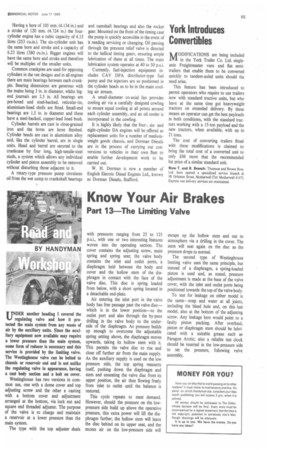Know Your Air Brakes
Page 67

If you've noticed an error in this article please click here to report it so we can fix it.
Part 13—The Limiting Valve
UiER another heading I covered the regulating valve and how it protected the main system from any waste of air by the auxiliary units. Since the auxiliary equipment now available may require a lower pressure than the main system, some form of reducer is necessary and this service is provided by the limiting valve. The Westinghouse valve can be bolted to chassis or reservoir end and is not unlike the regulating valve in appearance, having a cast body section and a bolt on cover.
Westinghouse has two versions in common use, one with a dome cover and top adjusting screw and the other a casting with a bottom cover and adjustment arranged at the bottom, via lock nut and square end threaded adjuster. The purpose of the valve is to charge and maintain a reservoir at a lower pressure than the main system.
The type with the top adjuster deals with pressures ranging from 25 to 125 p.s.i., with one or two interesting features woven into the operating section. The cover contains the adjusting screw, main spring and spring seat; the valve body contains the inlet and outlet ports, a diaphragm held between the body and cover and the hollow stem of the diaphragm in contact with the face of the valve disc. This disc is spring loaded from below, with a short spring located in a detachable end-plate.
Air entering the inlet port in the valve body has free passage past the valve disc— which is in the lower position—to the outlet port and also through the by-pass drilling in the valve body to the underside of the diaphragm. As pressure builds up enough to overcome the adjustable spring setting above, the diaphragm moves upwards, taking its hollow stem with it. This permits the valve disc to rise and close off further air from the main supply. As the auxiliary supply is used on the low pressure side, the top spring reasserts itself, pushing down the diaphragm and stem and unseating the valve disc from its upper position, the air then flowing freely from inlet to outlet until the balance is restored.
This cycle repeats to meet demand. However, should the pressure on the lowpressure side build up above the operative pressure, this extra power will lift the diaphragm further, the hollow stem will leave the disc behind on its upper seat, and the excess air on the low-pressure side will escape up the hollow stern and out to atmosphere via a drilling in the cover. The stem will seat again on the disc as the pressure drops to normal.
The second type of Westinghouse limiting valve uses the same principle, but instead of a diaphragm, a spring-loaded piston is used and, as stated, pressure adjustment is made at the base of the valve cover, with the inlet and outlet ports being positioned towards the top of the valve body.
To test for leakage on either model is the same—soap and water at all joints, including the bleed hole and, on this last model, also at the bottom of the adjusting screw. Any leakage here would point to a faulty piston packing. After overhaul, piston or diaphragm stem should be lubricated with a suitable grease such as Paragon Arctic; also a reliable test clock should be inserted in the low-pressure side to set the pressure, following valve assembly.




















































































































































